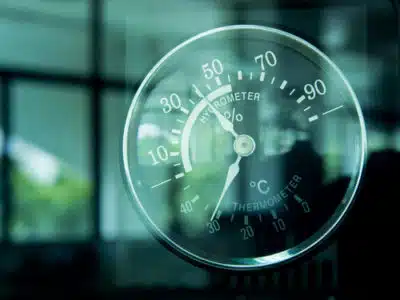
When most people think of home comfort, pleasant temperatures are the first thing that comes to mind. But did you know your home’s humidity level can also influence your sense of comfort? Some people prefer higher humidity, while others are better off with less. Finding the right balance can take some effort, but the benefits are worth it.
Humidity is measured by the amount of moisture vapor present in the surrounding air. According to the Mayo Clinic, the ideal range is between 30% to 50% humidity. Too little or too much can affect your indoor air quality, your health and even your home if mold grows or wood flooring cracks.
One of the easiest ways to control your home’s humidity is through a humidifier or dehumidifier. A humidifier pumps additional moisture into the air, while a dehumidifier draws it out. Homeowners in Omaha can benefit from both, due to dry winter air and humid summers.
Learn more about the different types of humidifiers and how they can benefit your home.
Types of Humidifiers
HVAC humidity control is managed primarily through humidity control systems. The two types of equipment are humidifiers and dehumidifiers.
Humidifier
A quality humidifier produces moisture for the surrounding air to absorb and circulate. Many systems use a reservoir of water to create the moisture vapor. They are available for single rooms or the entire home. Whole-house humidifiers are the best, since they connect to your HVAC system to distribute the humidity more evenly.
Dehumidifier
Dehumidifiers do the opposite. Excess moisture in the air is drawn into the dehumidifier. In these systems, the reservoir holds the condensed vapor. They are also available in single-room and whole-home models. Some systems are placed in the basement or under the house in crawl spaces.
Again, a whole-house humidifier is best solution since it can treat the air across your home. It works with your HVAC system to draw moisture out of the air and pipe it away through a drainage system.
Why A Whole-Home Dehumidifier Is Better Than a Portable One
A whole-home dehumidifier is a great way to reduce the humidity present in your home during the summer. Smaller units are restricted to single rooms or your basement. Another drawback is the dedicated reservoir. This tank must be emptied on a regular basis to function properly.
In the winter, a whole-home humidifier protects wood furniture and flooring, as well as your sense of comfort. Air that’s at the proper moisture level may also prevent you from getting sick as frequently during cold weather.
When your home’s air is at the right humidity level, it can make you feel more comfortable at a more energy-efficient temperature. This can help you save more on heating and cooling bills.
According to HomeAdvisor, you can expect to spend between $1,500 to $2,800 to install a whole-home system. Your total cost may vary depending on the size of your home and the model you choose.
5 Signs Your Home’s Humidity Is Too High and How to Control It
In general, high humidity is more common. It’s noticeable during warmer weather and can make staying comfortable surprisingly difficult. If your home suffers from high humidity, there are a number of problems that may appear. High humidity can encourage the growth of mold and mildew. It can make your skin feel clammy or sticky.
Here are some signs your home’s humidity is too high.
1. Aggravated Allergies or Asthma
High humidity can aggravate breathing problems including allergies or asthma. That’s because mold and mildew growth can trigger symptoms.
2. Discomfort
Your body will have a harder time cooling down when there’s excessive moisture in the air. This can affect your comfort and even your ability to sleep.
3. Wood Rotting or Warping
Moisture can affect anything in your home made of wood. This includes furniture, cabinets and flooring. Over time, the vapor seeps into the wood and may result in warping and fungus-related rot. Repairing wood rot damage can be expensive and time-consuming.
4. Mold
If your home’s humidity is out of control and you’re frequently smelling a musty odor, you might be dealing with mold. It thrives in high humidity and can be hazardous to your health. Plus, it can be expensive to remove if it spreads across your home.
5. Condensation on Windows and Walls
It’s normal to see some condensation on windows during the summer, especially in the morning when there’s a big difference between indoor and outdoor humidity levels. But ongoing condensation on windows and walls is concerning because it can rot wood frames and encourage mold growth.
How to Control High Humidity
The recommended humidity range is between 30% and 50% humidity. While very useful, a temperature and humidity controller isn’t your only option.
- Extra insulation can reduce the amount of humidity seeping in from outdoors.
- Air circulation prevents indoor air from becoming stagnant. Moving air dries out more easily. You can accomplish this with a ceiling fan or even a ventilation system that brings in fresh air from outdoors.
- Smart thermostat technology can be integrated with a dehumidifier or humidifier, so you can keep an eye on your home’s humidity levels and easily make adjustments.
A-1 United Provides Quality Humidity Solutions
A-1 United Heating, Air & Electrical installs and maintains Lennox® Healthy Climate® dehumidifiers and humidifiers. These whole-house systems provide convenient features like remote control and automatic humidity sensors. Controlling the humidity in your home will be fast and easy.
Our team of professional technicians are happy to help you find the humidity control solutions perfect for you. Get in touch with our staff for questions about available products and services. We can even provide a free estimate for any projects you’re considering. Schedule an appointment with A-1 United today by calling 402-593-7500.
